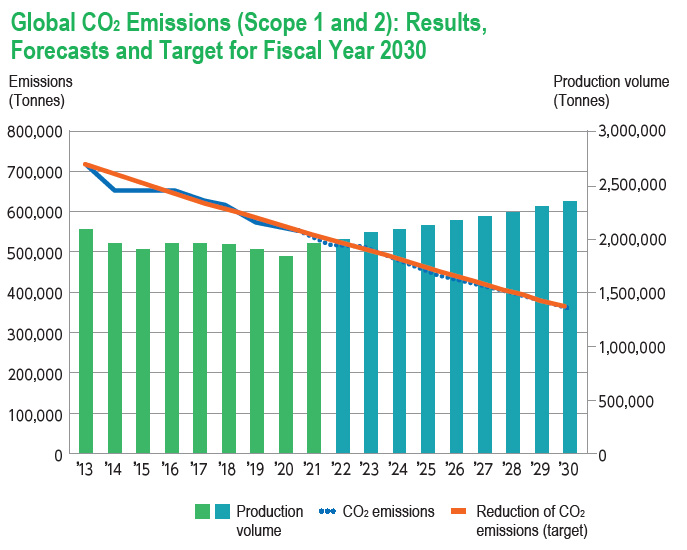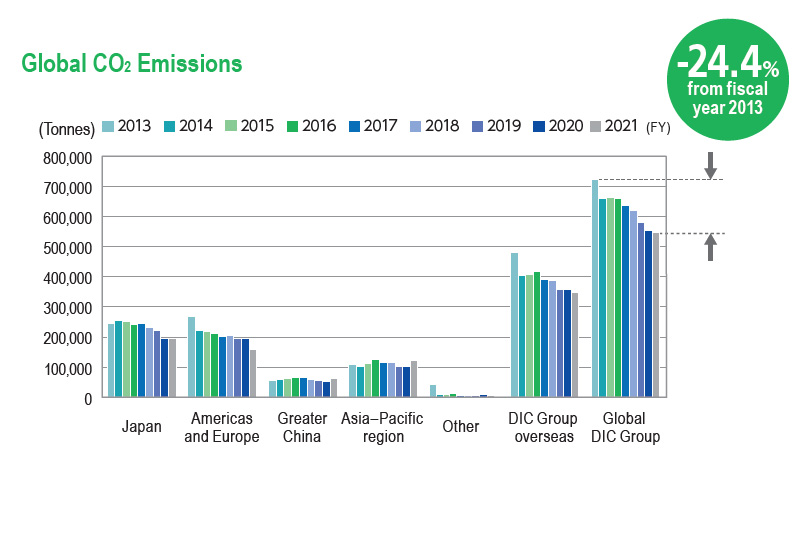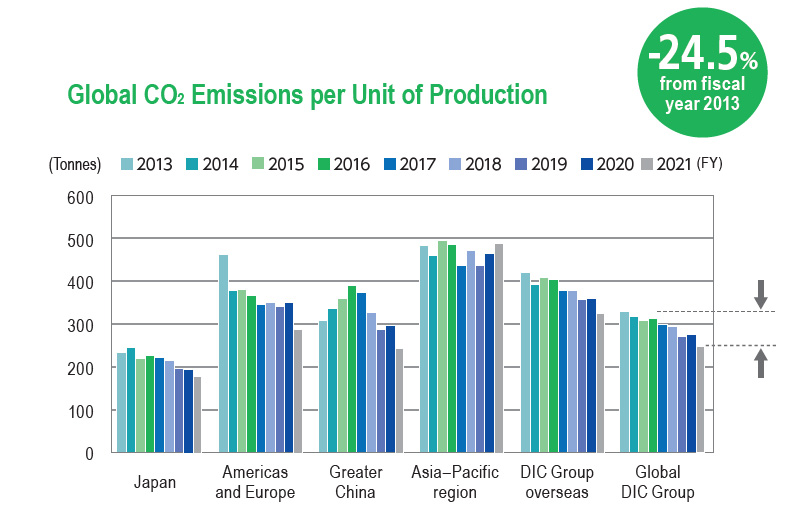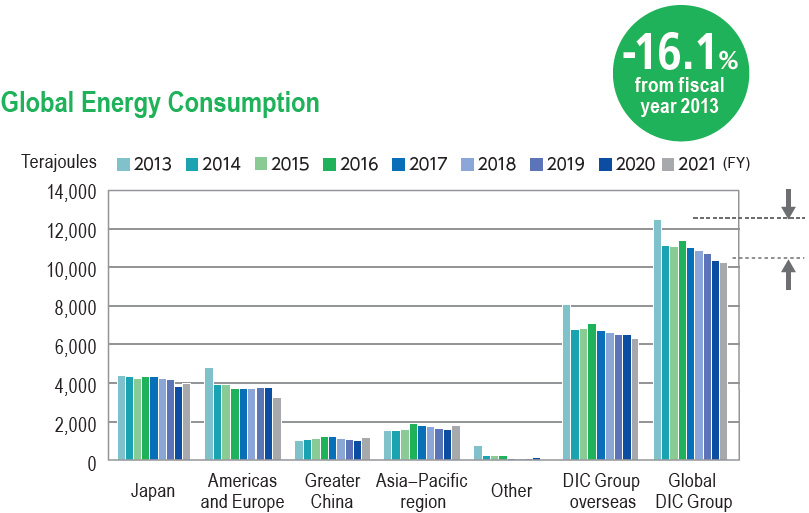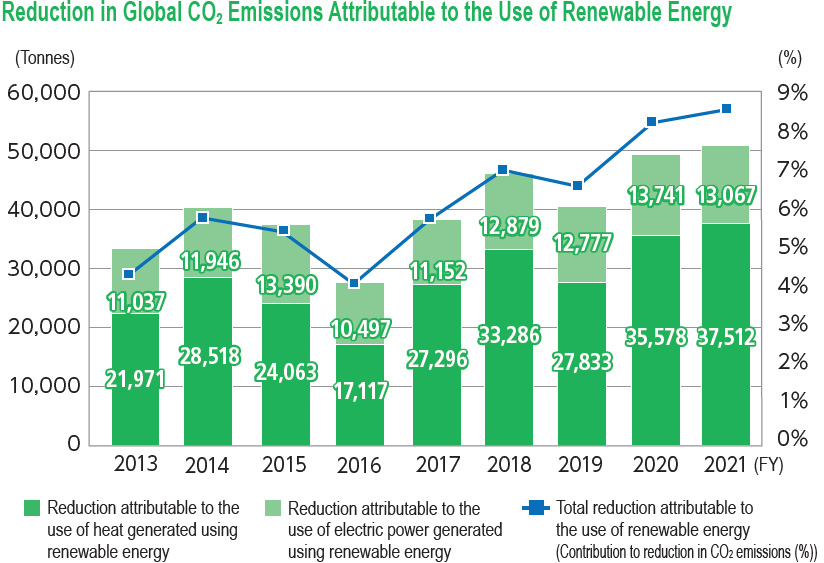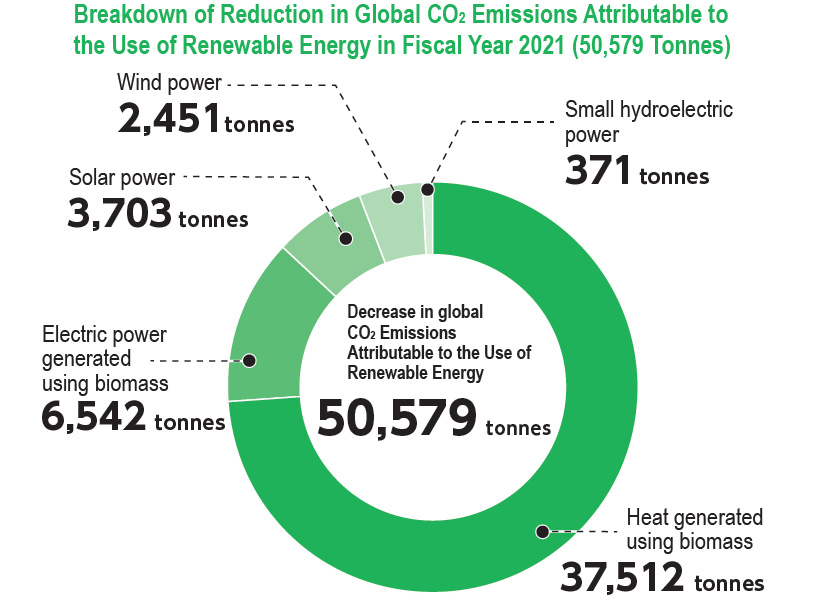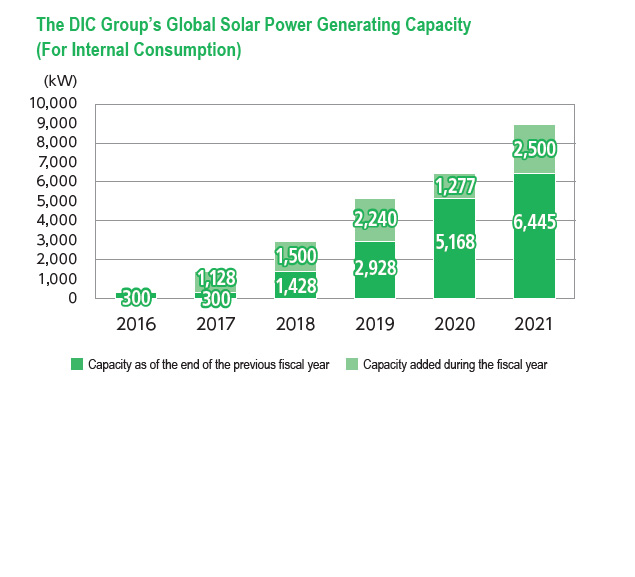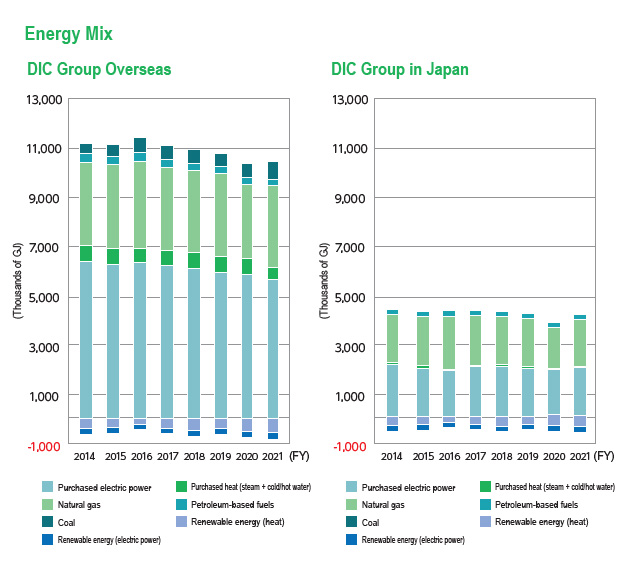Preventing Global Warming(2021)
Principal Initiatives in Fiscal Year 2021
01Energy Consumption and CO₂ Emissions (Scope 1 and 2) by the Global DIC Group
Energy consumption by the global DIC Group in fiscal year 2021 edged up 0.9% from fiscal year 2020 and 16.1% from the fiscal year 2013 base year. CO₂ emissions by the global DIC Group amounted to 546,304 tonnes, down 1.1% from fiscal year 2020 and 24.4% from fiscal year 2013, while CO₂ emissions per unit of production (Scope 1 and 2), at 246.8 kg/tonne, were down 9.2% from fiscal year 2020 and 24.5% from the base year.
The DIC Group’s diverse product portfolio includes printing inks, polymers, pigments, LCs, engineering plastics and compounds. Recent years have seen an uptrend in the output of energy-intensive fine chemicals and a downtrend in the output of general-purpose items, the production of which is comparatively energy efficient. Against this backdrop, the reason the Group fell short of its goal for reducing the volume of CO₂ it emits worldwide but succeeded in lowering CO₂ emissions per unit of production was efforts by Group companies worldwide to break down the target set forth in the three-year medium-term management plan that concluded in fiscal year 2021—a 50% decrease from the fiscal year 2013 level by fiscal year 2030—into an annual average decrease of 3.5% from the fiscal year 2018 level—and the promotion of ambitious energy-saving and decarbonization initiatives, including the incorporation of an internal carbon pricing system into capital investment projects. Some of these initiatives are outlined below.
Going forward, the Group will continue to implement a variety of energy-saving measures, including introducing highly efficient facilities, promoting process improvements and boosting capacity utilization rates, while at the same time further advancing its use of renewable energy by shifting to biomass and other clean fuels and installing solar power facilities.
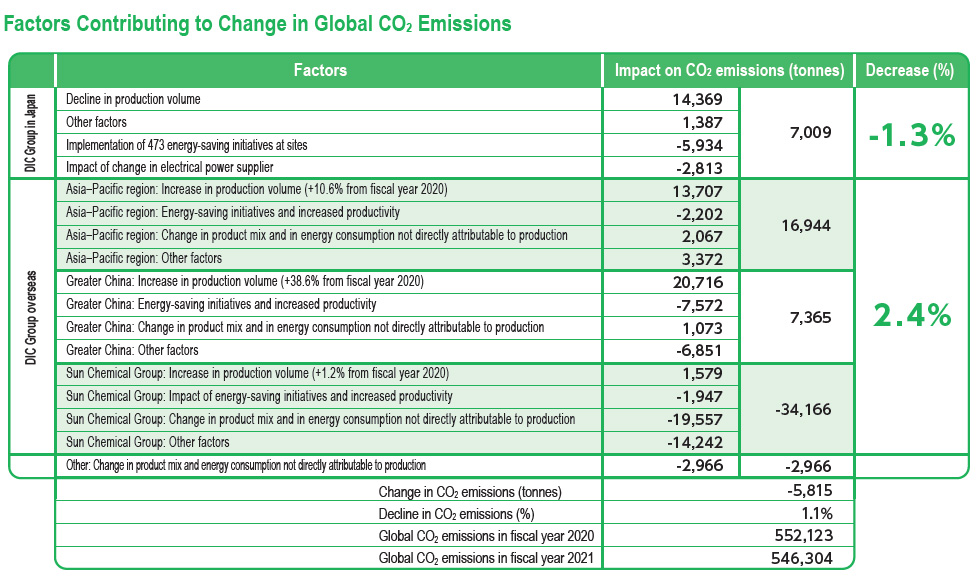
02Grasping CO₂ Emissions Across the Supply Chain (Scope 3)
The DIC Group recognizes the importance of reducing emissions of greenhouse gases across its supply chain and works to ensure a grasp of emissions in all categories of Scope 3. The Group has also revised its calculation for emissions in category 1 (Purchased goods and services) with the aim of refining data reported in this category.
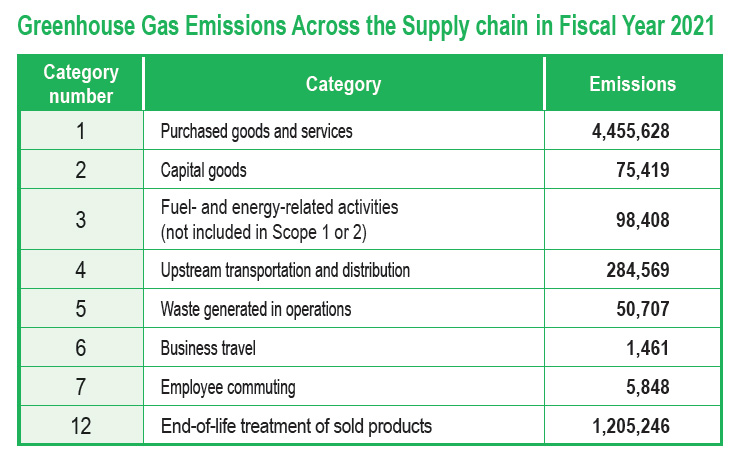
03Principal Initiatives in Fiscal Year 2021
Renewable Energy as a Percentage of Total Energy Used in Japan: 14.4%
The bulk of renewable energy used by DIC Group companies in Japan is natural energy generated by a biomass boiler and wind and solar power facilities at the Kashima Plant. In fiscal year 2021, DIC Group companies in Japan used 703,000 GJ renewable energy (equivalent to 18,143 kl of crude oil), up 2.4% from fiscal year 2020 and representing 14.4% of total energy (steam and electric power) consumed by these companies. The increase in renewable energy use was attributable to a variety of factors, including the fact that new biomass boilers (producing electric power, heat and steam) gradually came on line at the Kashima Plant, where priority was given to steam generation to improve efficiency.
The use of renewable energy by DIC Group companies in Japan in fiscal year 2021 accounted for a reduction in CO₂ emissions of 44,881 tonnes, or 18.2%, from the previous fiscal year. Going forward, DIC will continue to take decisive steps to advance its use of renewable energy with the aim of achieving its DIC NET ZERO 2050 target.
Adoption of Renewable Energy by the DIC Group Overseas
Against a global trend toward decarbonization, including by popularizing the use of renewable energy, DIC Group companies in the Asia–Pacific region, Greater China, and the Americas and Europe are making use of government subsidies and support to, for example, install biomass boilers and solar power facilities.
In fiscal year 2021, the global DIC Group used a total of 796,291 GJ of renewable energy, an increase of 1.9% from 781,542 GJ in fiscal year 2020. The use of renewable energy accounted for a reduction in the Group’s global CO₂ emissions of 50,579 tonnes.
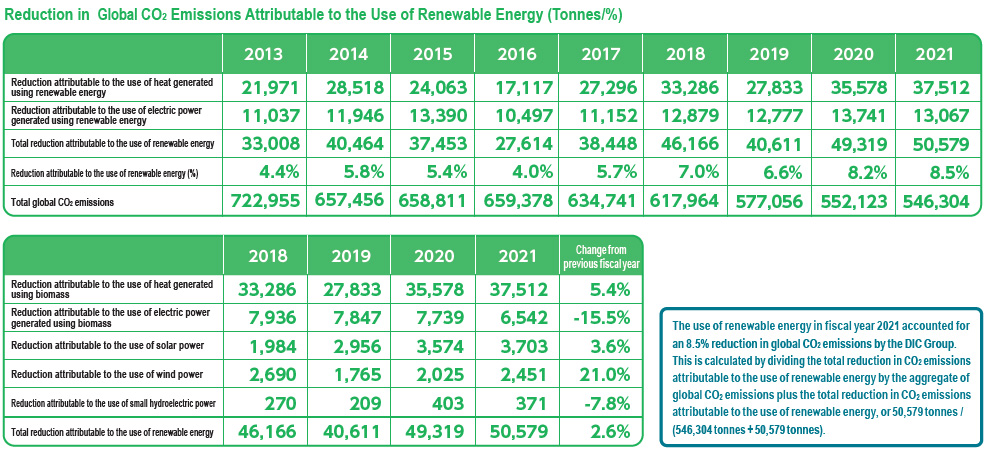
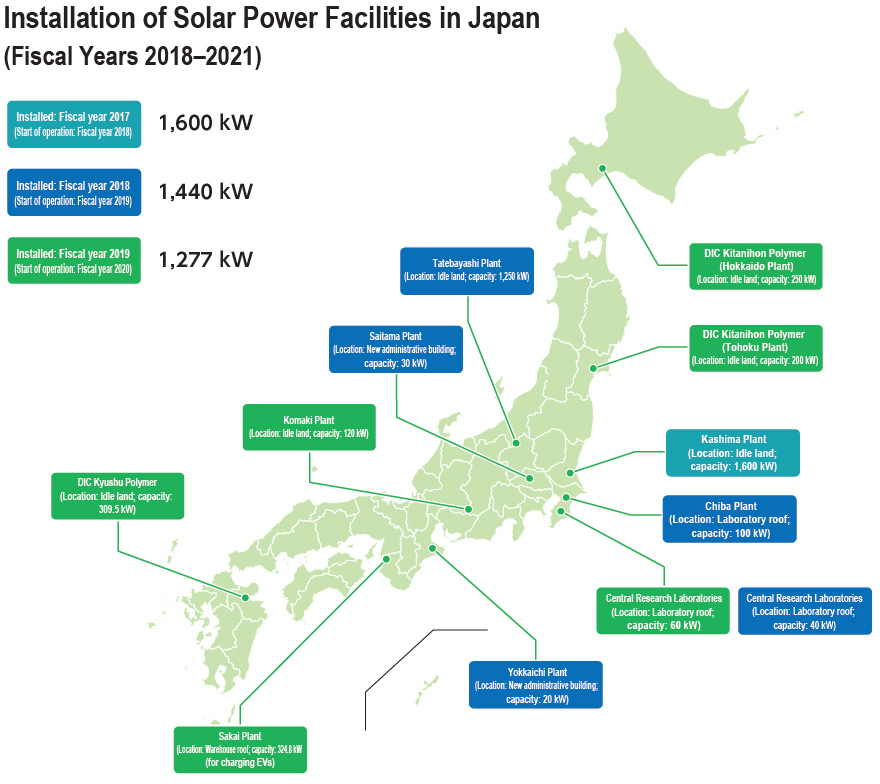
Initiatives in Areas Other than Production (Offices and Research Facilities)
In fiscal year 2021, energy consumed by the DIC Group’s 21 offices and research sites in Japan (excluding the Central Research Laboratories) rose 1.0%. Principal energy-saving initiatives implemented include replacing aged light fixtures and air conditioning equipment with newer, high-efficiency models that satisfy standards set by the Energy Conservation Center, Japan (ECCJ) for its Top Runner program, turning off lights when not needed and implementing mandatory 22°C winter and 28ºC summer air conditioning settings, working with facility management companies to implement diligent energy-saving measures and instituting a year-round no-jacket/no-tie dress code under the WSR 2020 project.
In a brand-new initiative for fiscal year 2021, Group company DIC Kyushu Polymer Co., Ltd., resolved to build a new office building that incorporates ZEB*1 construction, which aims to achieve virtually zero energy consumption.
The new office building was designed with a variety of energy-saving equipment and fixtures, including solar power generation facilities, heat insulation materials and LED lighting fixtures, to achieve a reduction in primary energy consumption (energy saving + energy creation) of 104%, earning it certification as a top-rank ZEB*2 building.
In addition, DIC Kyushu Polymer applied to participate in the 2021 ZEB demonstration project conducted the Ministry of Economy, Trade and Industry’s Agency for Natural Resources and Energy, earning certification as a ZEB Leading Owner.*3
DIC Kyushu Polymer is the first DIC Group company to pursue such an initiative. The DIC Group will continue working actively on building ZEBcompliant offices.
- A ZEB is a building with considerably reduced annual energy consumption by saving as much energy as possible via better heat insulation, solar shading, natural energy and high-efficiency equipment as well as creating energy (e.g., with photovoltaic power generation), while maintaining comfortable environments.
- The ZEB series consists of four ranks based on net reduction in primary energy consumption achieved: ZEB (net energy saving of 100% or more), Nearly ZEB (net energy saving of 75% or more), ZEB Ready (net energy saving of 50% or more) and ZEB-oriented (buildings with a floor space in excess of 10,000 m2 that achieve net energy saving of 40% or more).
- A ZEB Leading Owner is an owner of a ZEB building that publicly discloses its targets for promoting awareness of ZEB, introduction plans and implementation results, as well as the results of related efforts.
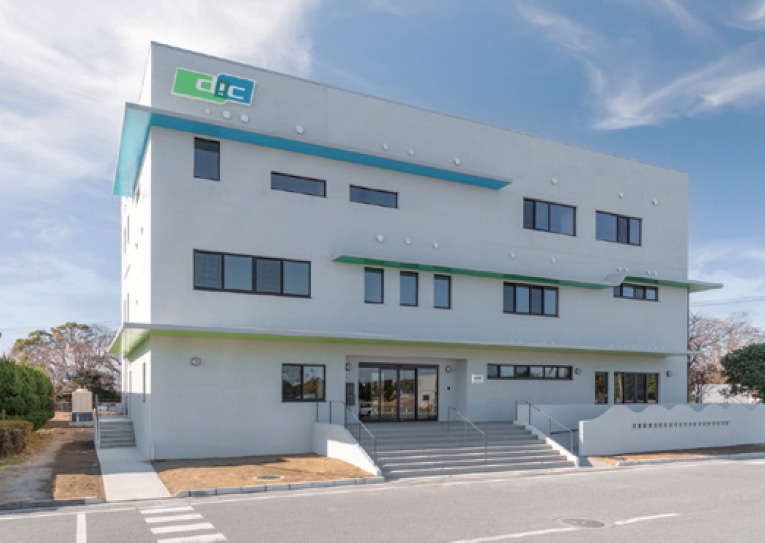
Procurement Initiatives
Based on the DIC Group Sustainable Procurement Guidelines, DIC formulated the DIC Group Sustainable Procurement Guidebook, version 3 of which was published in February 2020, which it uses to survey suppliers with the aim of reducing suppliers’ emissions of greenhouse gases. With the objective of better understanding and lowering the carbon footprint of DIC products, the Group is also making provisional calculations of the carbon footprint of the raw materials it uses, as well as seeking to expand its use of bioderived and recycled raw materials. The Group is further working to reduce greenhouse gas emissions using common tools such as EcoVadis.
Logistics Initiatives
In Japan, DIC is using fewer, larger trucks and taking decisive steps to improve loading efficiency, as well as promoting the use of modal shift and the efficient combination of truck, rail and marine transport. Overseas, DIC Group companies are advancing initiatives tailored to circumstances in individual countries and territories. Over the long term, the Group expects that the expanded use of next-generation vehicles and LNG carriers will further help reduce greenhouse gas emissions attributable to logistics.
Internal Carbon Pricing System
In fiscal year 2021, DIC introduced an internal carbon pricing system. Instituting its own internal price places a monetary value on greenhouse gas emissions (Scope 1 and 2) that the Company can then factor in cost–benefit assessments. This will allow more accurate capital investment decisions by making it possible to quantify the impact of emissions reductions while also raising awareness of the relationship between capital investments and CO₂ emissions. With the goal of expanding applications for its internal carbon pricing system, DIC will also look at using internal carbon pricing to factor the cost of emissions into calculations for energy procurement and rationalization efforts.
DIC Sustainability Index
The DIC Sustainability Index was established as a yardstick for measuring the social value of DIC Group products. The index’s vertical axis quantifies each product’ contribution to the reduction of environmental impact, which the DIC Group is working continuously to reduce. As it works to achieve its emissions reduction goals for fiscal years 2030 and 2050, the Group’s efforts to lower environmental impact focus on greenhouse gas emissions (Scope 1 and 2).
Calculating Products’ Carbon Footprint
To lower greenhouse gas emissions across its supply chain, the DIC Group calculates and works to minimize emissions associated with its products from the sourcing of raw materials through to provision to the customer. The Group is currently developing a scheme to calculate each product’s carbon footprint, which it believes will assist its efforts to promote dialogue with suppliers and to respond to customer expectations and social imperatives.
Avoided Emissions
The term “avoided emissions” refers to greenhouse gas emissions that can be avoided through the use of a product. Examples include products that contribute to improving fuel efficiency by reducing vehicle body weight and products that help reduce energy used for heating and cooling energy by improving insulation. The DIC Group is working to appropriately calculate avoided emissions and quantify the contribution thereof to the reduction of emissions across the supply chain, recognizing this as a key component of the value its products deliver.
Innovation
As part of its drive to achieve carbon neutrality, the DIC Group is promoting development efforts aimed at recovering CO₂, as well as recycling and converting recovered CO₂ into new raw material. The Group recognizes that active efforts to recover and reuse CO₂ will reduce its dependence on fossil fuels, contributing to decarbonization and the achievement of the target it has set for fiscal year 2050 under DIC NET ZERO.
The 2021 Excellent Energy Management Business Awards’ Ishikawa Prefectural Governor ’s Award
In February 2022, DIC’s Hokuriku Plant received the Ishikawa Prefectural Governor’s Award in the fiscal year 2021 Excellent Energy Management Business Operator Awards, sponsored by the Japan Electric Association’s Hokuriku Region Rationalization of Electric Power Use Committee, in recognition of its outstanding achievements in the rationalizing energy use.
The Hokuriku Region Rationalization of Electric Power Use Committee works with a number of relevant organizations and other bodies, as well as with the Toyama, Ishikawa and Fukui Prefectural Rationalization of Electric Power Use Committees, to nominate and commend business operators in the region for excellence in the effective use of energy. This program is part of a larger effort to promote effective energy use and regional industrial development.
DIC sees the Hokuriku Plant’s award as the result of the facility’s steady, ongoing efforts. Looking ahead, the DIC Group will continue to apply the related know-how it has cultivated to date at its sites in Japan and overseas as it steps up its efforts to promote effective energy use and achieve its DIC NET ZERO target for fiscal year 2050.
Protecting the Ozone Layer
Hydrofluorocarbons (HFCs) are used widely as refrigerants in equipment and facilities. While not an ozone-depleting substance (ODS), HFCs have a warming potential 100–10,000 times that of CO₂ and their use is expected to account for a 0.5°C increase in the global average temperature by the end of the 21st century. At the 28th Meeting of the Parties in Kigali, Rwanda, held in October 2016, the Parties to the Montreal Protocol on Substances that Deplete the Ozone Layer reached an agreement to phase out the production and use of HFCs (the Kigali Amendment). Japan subsequently amended its Act on the Protection of the Ozone Layer Through the Control of Specified Substances and Other Measures in line with the amendment, which as of November 10, 2021, had been ratified by 129 Parties. (Having surpassed the condition of ratification by at least 20 Parties, the Kigali Amendment entered into force on January 1, 2019.)
In April 2015, Japan also revised its Fluorocarbons Recovery and Destruction Law. The same month, the Act on Rational Use and Proper Management of Fluorocarbons entered into force, compelling stakeholders to ascertain and report leaks of fluorocarbons from commercial equipment and facilities.
In fiscal year 2021, leaked fluorocarbons from DIC Group sites were equivalent to 418 tonnes of CO₂. (Leaks in excess of 1,000 tonnes per site or per company must be reported to the Japanese authorities.) The Company has worked to effectively manage fluorocarbons since the enforcement of the Act on Rational Use and Proper Management of Fluorocarbons entered into force and has managed to keep leaks below the level requiring reporting. In fiscal year 2021, the Group’s efforts to comply with laws governing leaked fluorocarbons were recognized in the Japan Refrigerant and Environmental Organization’s first JRECO Fluorocarbon Rating, which selected it as one of 16 A-rank performers from among 1,350 companies surveyed. Going forward, the DIC Group will continue working to ensure compliance with pertinent laws and regulation, and to reduce leaked fluorocarbons from its sites.
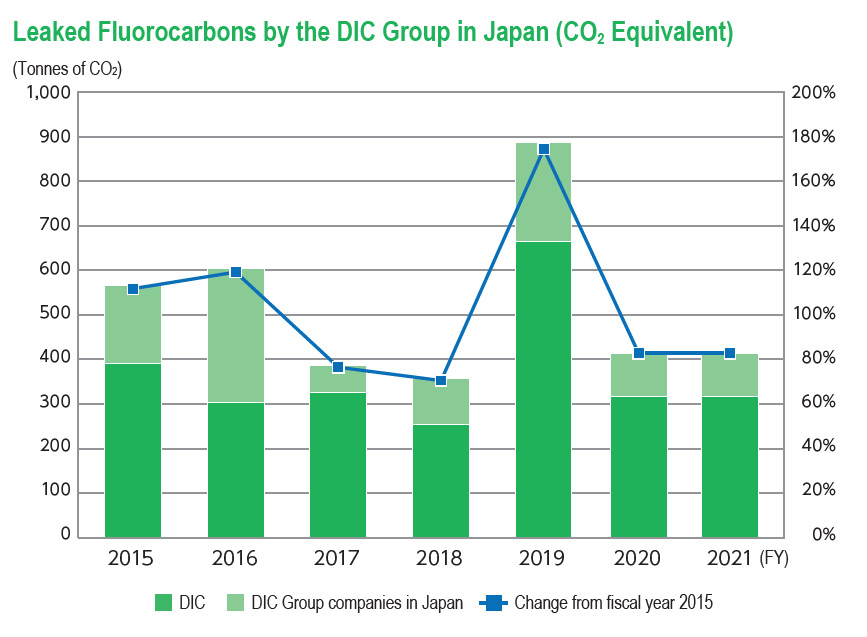
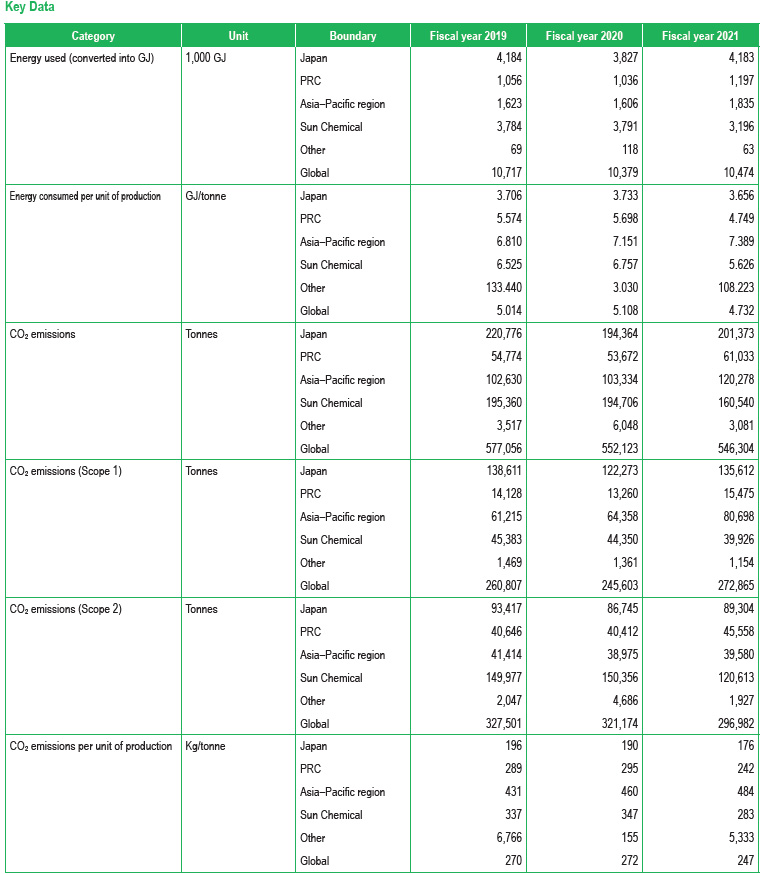
Back number
- Principal Initiatives in Fiscal Year 2023
- Principal Initiatives in Fiscal Year 2022
- Principal Initiatives in Fiscal Year 2021
- Principal Initiatives in Fiscal Year 2020
- Principal Initiatives in Fiscal Year 2019
- Principal Initiatives in Fiscal Year 2018
- Principal Initiatives in Fiscal Year 2017
- Principal Initiatives in Fiscal Year 2016
- Principal Initiatives in Fiscal Year 2015
- Principal Initiatives in Fiscal Year 2014
- Principal Initiatives in Fiscal Year 2013

